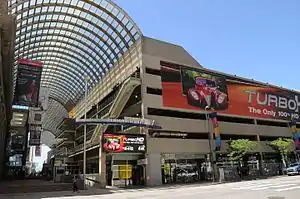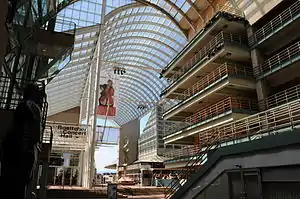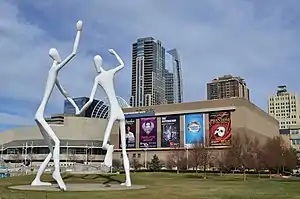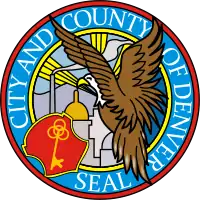Denver Performing Arts Complex
The Denver Performing Arts Complex (sometimes referred to locally as "The DCPA " or simply the "Arts Complex") is located in Denver, Colorado, in one of the largest performing arts centers in the United States. The DCPA is a four-block, 12-acre (49,000 m2) site containing ten performance spaces with over 10,000 seats connected by an 80 ft (24 m) tall glass roof.[1] It is home to a theatre company, Broadway musicals, contemporary dance and ballet, chorales, symphony orchestras, opera productions, pop stars and more.



The City and County of Denver’s Arts & Venues owns and operates the three largest theatres in DPAC, the Ellie Caulkins Opera House, the Buell Theatre and Boettcher Concert Hall. The Helen Bonfils Theatre Complex within DPAC is managed and operated by the Denver Center for the Performing Arts.
Performing arts organizations which regularly appear in one or other of the performance spaces include the Colorado Ballet, the Colorado Symphony, Opera Colorado and the Denver Center for the Performing Arts’ theatrical divisions — Denver Center Broadway and Denver Center Theatre Company.
Performance and other facilities
The Denver Performing Arts Complex houses the following performance spaces:
- The Ellie Caulkins Opera House, sometimes referred to as “the Ellie” is the main venue inside of the Quigg Newton Denver Municipal Auditorium. The Ellie is one of only three opera houses in the United States, one of nine worldwide, with seatback titling at every seat in the house. Its seating capacity is 2,225.
- The Buell Theatre is designed for amplified musicals, dramatic plays and comedy acts. Its seating capacity is 2,884.
- Boettcher Concert Hall is the nation's first symphony hall in the round designed to place the audience close to the stage – 80% of the seats are within 65 feet (20 m) of the stage. Its seating capacity is 2,679.
- Helen Bonfils Theatre Complex
The Wolf Theater is the largest of the four (4) theaters in the Bonfils Theatre Complex. It was previously known as the Stage Theatre. This is the most like a large commercial theater, with audio-enhancing walls and comfortable seats. It currently features 601 seats and a thrust stage. It was remodeled in 2020-2021 and its current name honors long-time patrons and benefactors in Denver's theater community.
The Kilstrom Theater was previously known as the Space Theatre. The audience surrounds the stage in what is called theatre in-the-round, This theatre was remodeled in 2017 with new wheelchair accessibility and was renamed in 2021. You can walk all the way around the outside walking area as it makes a complete ring around the theatre. You might double check your seat locations unless you're intentionally taking the long way around looking for seats. Just don't walk across the stage!
The Singleton Theatre was previously known as the Ricketson Theatre. Recently renamed to honor William Dean Singleton, who was involved in the creation of the DCPA in its early years, it has been recently remodeled to include easier elevator access. It has 250 seats in a proscenium theatre. It was originally created as an art-house movie theater.
The Jones Theatre features 200 seats and a thrust stage. It has a separate entrance on the outside of the building, near the intersection with Speer Boulevard. This theatre is often used for more experimental productions under the DCPA's Off-Center brand that often appeals to a younger or artistic crowd.
The Garner Galleria Theatre has 210-seats and is located separately within the complex. It resides inside a small restaurant-bar area underneath the large parking structure, and across the theater block's walking space from the DCPA's Broadway productions. This area is usually used for seated dinner theater, albeit with a limited menu. Some seats have tables and some have bar-like counters. It's a great place for families and first dates! This theater tends to have long-running productions, so if you see something you like, you can often see it again!
The Donald R. Seawell Grand Ballroom is a pentagonal shaped room with panoramic views of the mountains. This 10,000-square-foot (930 m2) facility holds a maximum capacity of 1,029 people. It can accommodate a variety of functions and performances, featuring its own catering kitchen, freight elevator, tables, chairs, portable dance floor, moveable platform staging and a lighting, audio, video and projection systems.
These spaces also host an annual new play festival attended by both locals and theatre critics from across the nation. These plays are not 'finsihed' and often are used as a sort of 'audition' for a full-fledged production. If you like to see how theatre works in progress, this is an excellent opportunity. Usually held in February/March.
Sculpture Park
Sculpture Park is located at the southwest corner of the complex at N. Speer Blvd. and Champa St. Often called 'the dancing aliens' locally because of the sculptures' scale, the official name is:
- Dancers by Jonathan Borofsky. Consists of two 60 foot silver-colored dancers made of steel and fiberglass[2][3]
See also
References
- "Archived copy". Archived from the original on 2017-09-13. Retrieved 2015-08-24.
{{cite web}}: CS1 maint: archived copy as title (link) - "Dancers - Denver Public Art".
- Dumb and Dumber: Jonathan Borofsky's "The Dancers" waltz into Denver. Michael Paglia. Westword. June 26, 2003. Accessed 2012-12-09.

